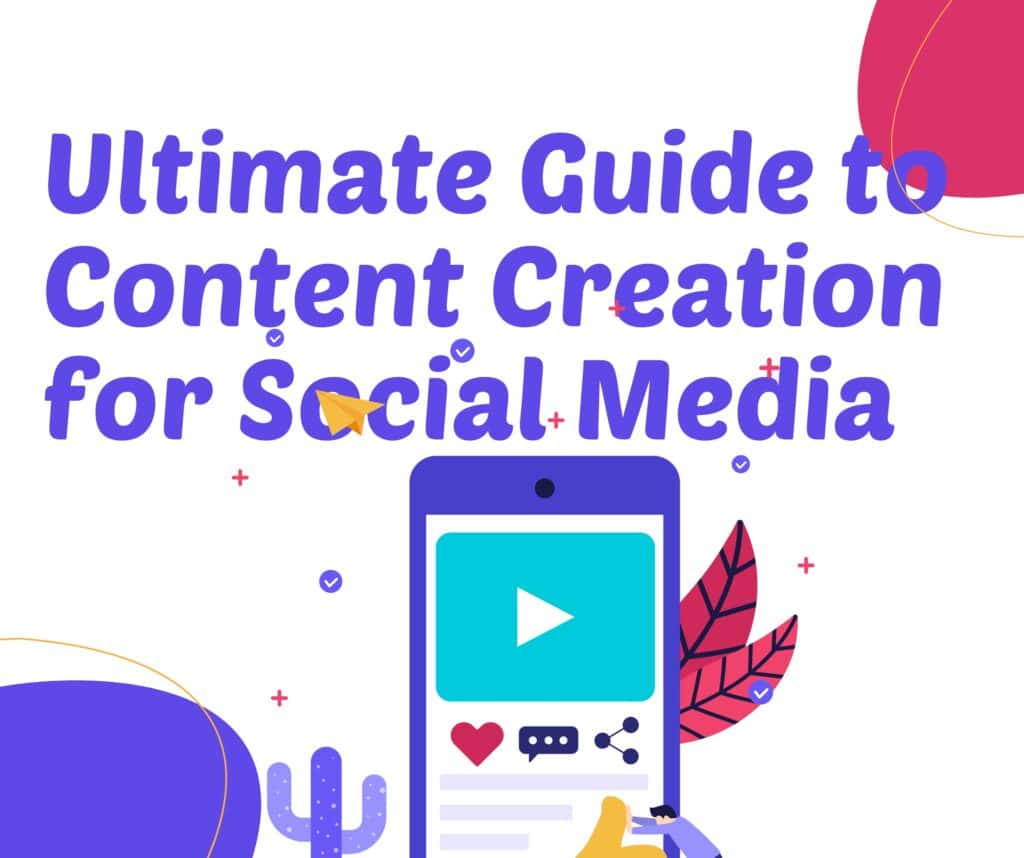Content creation is the backbone of social media marketing. It encompasses the development and sharing of various types of content—such as text, images, videos, and infographics—to engage with an audience and achieve marketing goals. In today’s digital landscape, creating high-quality content is crucial for building and maintaining a strong online presence. Effective content creation not only attracts potential followers but also retains and engages existing ones, fostering a loyal community around your brand.
How Quality Content Drives Engagement and Growth
Quality content is the driving force behind social media engagement and growth. Here’s how it impacts these areas:
- Attracts Attention: Well-crafted content captures the interest of your target audience, making them more likely to follow, like, share, or comment on your posts. This initial attraction is essential for growing your social media presence.
- Encourages Interaction: Engaging content encourages users to interact with your brand. This interaction can lead to increased visibility through likes, shares, and comments, which can, in turn, reach a wider audience.
- Builds Trust and Authority: Consistently delivering valuable, relevant, and high-quality content establishes your brand as an authority in your field. This builds trust with your audience, making them more likely to engage with and support your brand.
- Drives Conversions: Quality content can lead to higher conversion rates by effectively guiding users through the customer journey, from awareness to consideration and finally to action (e.g., making a purchase, signing up for a newsletter).
Launch your online business today. Click below.
Try Wealthy Affiliate (For Free).
Overview of the Key Elements of Successful Social Media Content
Successful social media content is characterized by several key elements:
- Relevance: Content must be relevant to your audience’s interests and needs. This involves understanding your audience’s preferences and aligning your content with current trends and topics that resonate with them.
- Value: Providing value through informative, entertaining, or inspiring content helps to engage and retain your audience. This could mean offering solutions to problems, sharing useful tips, or delivering captivating stories.
- Visual Appeal: High-quality visuals, including images, graphics, and videos, play a crucial role in content success. Visuals should be eye-catching and aligned with your brand’s aesthetic to capture attention and enhance message delivery.
- Consistency: Regular posting and maintaining a consistent voice and style help to build a recognizable brand presence. Consistency in content scheduling and messaging strengthens your brand identity and keeps your audience engaged.
- Call-to-Action (CTA): Effective content includes clear CTAs that guide your audience on what to do next. Whether it’s visiting a website, signing up for a webinar, or making a purchase, a well-placed CTA drives user actions and conversions.
Understanding Your Audience
Defining Your Target Audience
Understanding your target audience is the foundation of effective content creation. Your target audience is the specific group of people you aim to reach with your social media content. Defining this audience involves several key factors:
- Age: Knowing the age range of your audience helps tailor content to their preferences and communication styles. For instance, younger audiences may prefer trending memes and short-form videos, while older audiences might appreciate more detailed articles or traditional content formats.
- Gender: Understanding the gender distribution within your audience can guide content choices and marketing strategies. This knowledge allows you to create content that resonates with specific gender-related interests or concerns.
- Interests: Identifying the interests and hobbies of your audience helps in crafting content that appeals to their passions. This could include topics related to their favorite activities, industry trends, or emerging technologies they follow.
- Demographics: Beyond basic age and gender, demographic details such as location, education level, and occupation provide deeper insights into your audience. This information can influence content tone, language, and relevance.
Analyzing Audience Behavior and Preferences
To effectively engage your target audience, it’s crucial to analyze their behavior and preferences. Here’s how to approach this analysis:
- Social Media Analytics: Utilize analytics tools provided by social media platforms to gather data on user interactions, engagement rates, and content performance. Insights such as the time of day your audience is most active or the types of content they engage with most can inform your content strategy.
- Surveys and Polls: Conduct surveys and polls to gather direct feedback from your audience. Questions can cover content preferences, favorite topics, and feedback on past content. This method provides valuable input straight from your audience.
- Engagement Metrics: Track metrics like likes, shares, comments, and click-through rates to understand which content types resonate best. High engagement levels often indicate that your content is hitting the mark with your audience.
- Competitor Analysis: Study your competitors to see what content strategies work for them. Analyzing their audience engagement can offer insights into industry trends and gaps in your own content approach.
Creating Audience Personas
Audience personas are fictional representations of your ideal audience members based on real data and research. Creating these personas helps in developing more targeted and effective content. Here’s how to create them:
ommission. These links provide access to valuable tools and training to help you succeed online.
- Gather Data: Compile data from various sources, including social media analytics, website traffic, and customer feedback. Look for patterns and common characteristics among your audience.
- Identify Key Attributes: Determine the key attributes of your personas, such as age, gender, occupation, interests, and pain points. Create detailed profiles that include their goals, challenges, and how they interact with social media.
- Develop Persona Profiles: Create comprehensive profiles for each persona, including a name, photo, and a brief description of their background and preferences. This helps humanize your target audience and makes it easier to tailor content to their needs.
Disclosure: This post contains affiliate links. If you purchase through them, I may earn a commission. These links provide access to valuable tools and training to help you succeed online.
Try Wealthy Affiliate (For Free).
Tools and Methods for Persona Development
Several tools and methods can assist in developing detailed audience personas:
- Google Analytics: Use Google Analytics to gather demographic and behavioral data about your website visitors. This data helps in understanding your audience’s characteristics and interests.
- Social Media Insights: Platforms like Facebook Insights and Instagram Analytics provide data on your followers’ demographics, interests, and behaviors, aiding in persona development.
- Surveys and Questionnaires: Tools like SurveyMonkey or Google Forms allow you to create surveys that collect detailed information about your audience’s preferences and behaviors.
- Persona Templates: Use pre-designed persona templates available online to structure your personas effectively. These templates often include sections for goals, challenges, and behavior patterns.
Tailoring Content to Different Personas
Once you have developed your audience personas, tailor your content to address their specific needs and preferences:
- Customize Messaging: Craft messages that speak directly to each persona’s interests and pain points. This ensures that your content is relevant and engaging.
- Choose Appropriate Formats: Different personas may prefer different types of content. For example, a visual learner might appreciate infographics or video content, while a reader might prefer in-depth articles or blog posts.
- Adjust Tone and Style: Adapt the tone and style of your content to match the persona’s preferences. For instance, a professional persona might appreciate a formal tone, while a younger, casual persona might respond better to a more relaxed and conversational style.
Crafting Engaging Content
Types of Social Media Content
Creating engaging social media content involves using various formats to capture and maintain audience interest. Here’s a closer look at the types of content you can create:
- Text Posts: Tips for Compelling Copy
- Clarity and Brevity: Keep your text clear and to the point. Aim for concise, impactful messages that are easy to read and understand.
- Engaging Headlines: Craft attention-grabbing headlines that encourage users to read more. Use strong, action-oriented words that spark curiosity or offer value.
- Call-to-Action (CTA): Include a CTA that prompts users to take action, such as liking, sharing, commenting, or visiting your website. A well-placed CTA can drive higher engagement.
- Personalization: Use personalized language that resonates with your audience. Addressing readers directly can make your content feel more relevant and engaging.
- Images and Videos: Best Practices for Visual Content
- High-Quality Visuals: Use high-resolution images and well-edited videos to maintain a professional appearance. Avoid pixelated or blurry visuals.
- Brand Consistency: Ensure that your visuals align with your brand’s style and color scheme. Consistency helps build brand recognition and trust.
- Visual Storytelling: Use images and videos to tell a story or convey a message. Visual storytelling can be more engaging than text alone and helps in capturing emotions and context.
- Optimization: Optimize visuals for each platform’s specifications. Different platforms have varying size requirements and aspect ratios for images and videos.
- Stories and Reels: Engaging Formats and Trends
- Ephemeral Content: Stories and reels are temporary and appear for a limited time, creating a sense of urgency and exclusivity. Use these formats for time-sensitive updates or behind-the-scenes content.
- Interactive Features: Take advantage of interactive elements such as polls, questions, and quizzes to engage users and gather feedback. These features can increase interaction and involvement.
- Creative Effects: Utilize filters, stickers, and effects to enhance the visual appeal of your stories and reels. Creative elements can make your content stand out and attract more viewers.
- Trends and Challenges: Participate in trending challenges and use popular music or effects to increase visibility. Staying current with trends can help your content reach a broader audience.
Content Themes and Topics
Developing relevant and interesting content themes and topics is crucial for maintaining engagement and relevance:
- Identifying Trending Topics and Hashtags
- Trend Monitoring: Use tools and platforms such as Google Trends, Twitter Trends, or social media listening tools to identify trending topics and conversations. This helps in creating timely and relevant content.
- Hashtag Research: Research popular hashtags related to your industry or content. Using trending hashtags can increase your content’s visibility and discoverability.
- Competitor Analysis: Observe the content themes and topics your competitors are focusing on. This can provide insights into industry trends and opportunities for your own content.
- Incorporating Brand Voice and Messaging
- Consistent Tone: Maintain a consistent tone and voice that reflects your brand’s personality. Whether it’s formal, casual, humorous, or authoritative, consistency helps in building a recognizable brand identity.
- Value Alignment: Ensure that your content aligns with your brand’s values and messaging. This consistency reinforces your brand’s message and helps in establishing a strong connection with your audience.
- Authenticity: Be authentic in your content. Genuine and honest communication fosters trust and credibility with your audience.
Content Planning and Scheduling
Effective content planning and scheduling are key to maintaining a consistent and organized social media presence:
- Creating a Content Calendar
- Content Topics: Plan out content themes and topics for each week or month. A content calendar helps in organizing your content strategy and ensuring a diverse mix of posts.
- Scheduling Posts: Determine the best times to post based on your audience’s activity patterns. Scheduling posts in advance helps in maintaining consistency and reaching your audience at optimal times.
- Special Events: Include special dates, holidays, and promotional events in your calendar. Planning for these events ensures timely and relevant content.
- Tools for Scheduling and Automation
- Social Media Management Tools: Use tools such as Hootsuite, Buffer, or Sprout Social to schedule posts and manage multiple social media accounts from a single platform. These tools can save time and streamline your social media management.
- Automated Posting: Set up automated posting for your content to ensure regular updates without manual intervention. Automation tools can help in maintaining a consistent posting schedule.
- Performance Tracking: Many scheduling tools offer analytics features that track post performance and engagement. Use these insights to refine your content strategy and improve future posts.
Designing Visual Content
Visual Design Principles
Designing visually appealing content is essential for capturing and retaining your audience’s attention. Here are some fundamental visual design principles to consider:
- Importance of Brand Consistency
- Visual Identity: Maintain a consistent visual identity across all your content. This includes using the same color palette, typography, and logo placement to reinforce brand recognition. Consistency helps in building a cohesive brand image and makes your content easily identifiable.
- Brand Guidelines: Develop and adhere to brand guidelines that outline how your brand’s visual elements should be used. This ensures that all content aligns with your brand’s aesthetics and messaging, providing a uniform experience across different platforms.
- Using Color, Typography, and Imagery Effectively
- Color Psychology: Choose colors that evoke the desired emotions and align with your brand’s personality. For example, blue often conveys trust and professionalism, while red can signify excitement and urgency. Ensure your color choices are harmonious and complement each other.
- Typography: Select fonts that are readable and reflect your brand’s tone. Use no more than two or three complementary fonts to maintain visual harmony. Pay attention to font size, spacing, and alignment to enhance readability and aesthetic appeal.
- Imagery: Use high-quality images that are relevant to your content and resonate with your audience. Ensure images are well-composed and properly lit. Avoid stock photos that look generic and instead opt for authentic visuals that represent your brand’s uniqueness.
Tools for Creating Visuals
Utilizing the right tools can significantly enhance the quality and efficiency of your visual content creation:
- Graphic Design Software and Apps (e.g., Canva, Adobe Spark)
- Canva: Canva is a user-friendly design tool that offers a wide range of templates, graphics, and fonts. It’s ideal for creating social media posts, infographics, and other visual content without requiring advanced design skills. Canva’s drag-and-drop interface makes it easy to customize designs.
- Adobe Spark: Adobe Spark provides powerful design features for creating graphics, web pages, and videos. It offers a range of templates and design elements that can be customized to fit your brand. Spark is particularly useful for creating visually engaging content quickly.
- Adobe Creative Suite: For more advanced design needs, Adobe Creative Suite (including Photoshop, Illustrator, and InDesign) offers professional-grade tools for image editing, vector graphics, and layout design. These tools provide greater flexibility and control for experienced designers.
- Tips for Creating High-Quality Images and Videos
- Resolution: Ensure that images and videos are high-resolution to maintain clarity and professionalism. Avoid pixelation or blurriness by using images with at least 1080p resolution for social media posts.
- Composition: Follow basic composition principles such as the rule of thirds, leading lines, and framing to create visually appealing images. Well-composed visuals are more engaging and effective in conveying your message.
- Lighting: Use natural or well-controlled artificial lighting to enhance the quality of your images and videos. Good lighting can improve clarity, color accuracy, and overall visual appeal.
- Editing: Edit images and videos to enhance their quality and align them with your brand’s style. Use editing tools to adjust brightness, contrast, saturation, and color balance. Be mindful not to over-edit, as this can make visuals appear unnatural.
- Consistency: Apply consistent filters, effects, and editing styles to maintain a cohesive look across your content. This consistency helps in reinforcing your brand’s visual identity and making your content recognizable.
Optimizing Content for Each Platform
Platform-Specific Strategies
Each social media platform has its own unique features, user behavior, and content preferences. Tailoring your content strategy to fit each platform can maximize engagement and effectiveness. Here’s a breakdown of best practices for major social media platforms:
- Facebook: Best Practices for Engagement
- Content Variety: Use a mix of content types, including text posts, images, videos, and links. Facebook’s algorithm favors diverse content that keeps users engaged.
- Engaging Headlines and Copy: Craft compelling headlines and engaging copy that encourages likes, comments, and shares. Ask questions, share interesting facts, or use calls-to-action to prompt interactions.
- Facebook Groups: Participate in or create Facebook Groups related to your industry. Engaging in groups can help build a community and drive more focused conversations around your content.
- Live Videos: Utilize Facebook Live for real-time interaction. Live videos can boost engagement and reach due to Facebook’s algorithm prioritizing live content.
- Instagram: Using Hashtags, Stories, and IGTV
- Hashtags: Use relevant and trending hashtags to increase the discoverability of your posts. Combine popular hashtags with niche-specific ones to reach both broad and targeted audiences.
- Stories: Instagram Stories are a powerful tool for engaging users with ephemeral content. Use Stories to share behind-the-scenes glimpses, updates, polls, and interactive content. Stories appear at the top of users’ feeds, making them highly visible.
- IGTV: Leverage IGTV for longer video content. IGTV allows for up to 60 minutes of video, making it ideal for in-depth tutorials, interviews, or series. Ensure your IGTV videos are engaging from the start to retain viewer attention.
- Visual Consistency: Maintain a visually cohesive feed by using consistent colors, filters, and styles. A well-curated Instagram feed helps in establishing a strong brand identity.
- Twitter: Crafting Concise and Impactful Tweets
- Character Limit: With a 280-character limit, craft concise and impactful tweets. Focus on clear and engaging messages that can be easily read and understood quickly.
- Hashtags and Mentions: Use relevant hashtags to increase visibility and join conversations. Mention other users or brands to foster engagement and expand your reach.
- Visuals: Include images, GIFs, or videos to make your tweets stand out. Visuals can increase engagement and make your content more memorable.
- Timely Updates: Leverage Twitter for real-time updates and news. Share timely and relevant content to capitalize on trending topics and current events.
- LinkedIn: Professional Content and Networking
- Professional Tone: Use a professional tone and focus on industry-related content. LinkedIn is a platform for networking and sharing professional insights, so ensure your content aligns with these expectations.
- Long-Form Articles: Publish long-form articles or LinkedIn posts to share in-depth knowledge and expertise. Thought leadership content can help establish your authority in your field.
- Networking: Engage with industry peers by commenting on posts, joining groups, and participating in discussions. Networking on LinkedIn can lead to valuable connections and opportunities.
- Company Updates: Share company news, achievements, and employee spotlights to build your brand’s presence and engage with your professional network.
Analyzing Platform Algorithms
Understanding and adapting to each platform’s algorithm is crucial for optimizing content visibility and engagement:
- Understanding How Algorithms Affect Content Visibility
- Engagement Metrics: Social media algorithms prioritize content that generates high engagement (likes, comments, shares). Content that receives more interactions is more likely to be shown to a wider audience.
- Relevance and Recency: Algorithms often consider the relevance and recency of content. Recent and relevant posts are more likely to appear in users’ feeds, so posting timely and pertinent content is beneficial.
- User Behavior: Platforms analyze user behavior to determine what content to show. Algorithms consider factors such as user interactions, preferences, and the type of content they engage with most frequently.
- Adapting Your Strategy to Platform Changes
- Stay Updated: Social media platforms frequently update their algorithms and features. Stay informed about changes by following platform blogs, industry news, and updates from social media experts.
- Experiment and Analyze: Continuously experiment with different content types, posting times, and engagement strategies. Analyze performance metrics to understand what works best for each platform and adapt your approach accordingly.
- Optimize Based on Insights: Use insights and analytics tools provided by the platforms to refine your content strategy. Adjust your content based on what resonates most with your audience and aligns with algorithm preferences.
Measuring and Analyzing Performance
Key Metrics to Track
To effectively measure and improve your social media performance, it’s crucial to track and analyze key metrics. These metrics provide insights into how well your content is resonating with your audience and achieving your goals. Here’s a breakdown of essential metrics to monitor:
- Engagement Rates (Likes, Shares, Comments)
- Likes: This metric indicates how many users appreciated your content. While likes alone don’t provide deep insights, they can help gauge the initial reaction to your posts.
- Shares: Shares demonstrate how much users find your content valuable or interesting enough to share with their own network. High share rates can signal that your content has broad appeal and is engaging.
- Comments: Comments offer qualitative feedback and can help you understand audience sentiment. Monitoring the volume and nature of comments can reveal how your audience is responding to your content and provide opportunities for further engagement.
- Reach and Impressions
- Reach: Reach refers to the number of unique users who have seen your content. Tracking reach helps assess the effectiveness of your content in reaching a broad audience.
- Impressions: Impressions measure how often your content is displayed, regardless of whether it was clicked or not. This metric helps determine how frequently your content appears in users’ feeds and the overall visibility of your posts.
- Click-Through Rates (CTR) and Conversions
- Click-Through Rate (CTR): CTR measures the percentage of users who click on a link within your content compared to the number of users who saw the post. A higher CTR indicates that your content is compelling and effectively driving users to take action.
- Conversions: Conversions track the number of users who complete a desired action, such as signing up for a newsletter, making a purchase, or downloading an app. Analyzing conversion rates helps evaluate the effectiveness of your content in driving specific outcomes.
Using Analytics Tools
Analytics tools provide valuable data and insights that help you refine your social media strategy. Here’s an overview of key tools and how to use them:
- Overview of Tools
- Google Analytics: Google Analytics is a comprehensive tool that tracks website traffic, user behavior, and conversion data. It helps you understand how social media traffic interacts with your website, which content drives the most engagement, and how users navigate through your site.
- Social Media Insights: Most social media platforms offer built-in analytics tools (e.g., Facebook Insights, Instagram Insights, Twitter Analytics) that provide detailed information on post performance, audience demographics, and engagement metrics. These insights help you understand what content works best on each platform and how to optimize your strategy.
- Interpreting Data to Refine Your Content Strategy
- Identify Trends: Analyze the data to identify trends and patterns in user behavior. For example, if certain types of content consistently receive higher engagement, focus on creating more of that content.
- Adjust Content Strategy: Use insights from metrics such as CTR and conversions to adjust your content strategy. If you notice that certain posts drive higher click-through rates, consider replicating those elements in future content.
- Optimize Posting Times: Data on reach and impressions can help you determine the best times to post. Schedule your content when your audience is most active to maximize visibility and engagement.
- Evaluate Audience Segments: Analyze audience demographics and behavior to tailor your content to different segments. For instance, if a specific age group or interest category shows higher engagement, create content that appeals directly to that segment.
Ready to change your life? Click here to get started.
Try Wealthy Affiliate (For Free).
Tips for Continuous Improvement
Continuous improvement is key to maintaining an effective social media strategy. By regularly testing, experimenting, and staying updated with trends, you can refine your approach and achieve better results. Here’s how to approach continuous improvement:
A/B Testing and Experimentation
A/B testing, also known as split testing, is a method used to compare two versions of content to determine which performs better. Experimentation involves trying out new ideas to see what resonates with your audience. Both are essential for optimizing your social media strategy.
- Testing Different Content Formats and Strategies
- Content Formats: Experiment with various content formats such as images, videos, infographics, and text posts. A/B test different styles, lengths, and types of content to identify what drives the most engagement and conversion.
- Posting Times: Test different posting times to find out when your audience is most active and likely to engage. Schedule posts at various times of the day and week to determine optimal posting schedules.
- Headlines and CTAs: Experiment with different headlines and calls-to-action (CTAs) to see which versions generate higher click-through rates and engagement. Minor changes in wording can sometimes make a significant impact.
- Analyzing Results and Making Data-Driven Decisions
- Evaluate Performance: Use analytics tools to compare the performance of different content variations. Look at metrics such as engagement rates, click-through rates, and conversion rates to determine which version performs best.
- Learn and Adapt: Analyze the results to understand why certain content or strategies worked better. Apply these insights to future content creation and strategy adjustments. For example, if videos performed better than images, consider incorporating more video content into your strategy.
- Iterate and Refine: Continuously refine your approach based on the data collected. Regularly update your content strategy to incorporate successful elements and eliminate less effective ones.
Staying Updated with Trends
Staying current with industry trends and updates is crucial for maintaining relevance and leveraging new opportunities. Social media is a dynamic field, and keeping up with trends can help you stay ahead of the competition.
- Keeping Up with Industry Trends and Updates
- Follow Industry Leaders: Subscribe to blogs, newsletters, and social media accounts of industry leaders and experts. They often provide insights into the latest trends, tools, and best practices.
- Attend Webinars and Conferences: Participate in webinars, workshops, and conferences related to social media marketing. These events can offer valuable knowledge about emerging trends and new strategies.
- Use Trend Monitoring Tools: Leverage tools such as Google Trends, BuzzSumo, and social media trend trackers to monitor what’s currently popular in your industry. These tools can help you identify trending topics and popular content formats.
- Adapting Your Content Strategy Based on New Insights
- Incorporate Trends: Integrate relevant trends and insights into your content strategy. For example, if a new social media feature or content format becomes popular, consider experimenting with it to engage your audience.
- Adjust Messaging: Update your messaging to reflect current events, industry changes, or evolving audience preferences. Staying relevant helps in maintaining audience interest and engagement.
- Innovate and Experiment: Be open to trying new approaches and innovative ideas. Experiment with emerging technologies, content formats, and strategies to see what resonates with your audience and drives better results.
Conclusion
Recap of Key Points
In this article, we’ve explored the crucial elements of creating and optimizing social media content to enhance engagement and achieve your goals. Here’s a quick recap of the key points discussed:
- Introduction to Content Creation for Social Media: We emphasized the importance of high-quality content in driving engagement and growth, and outlined the fundamental elements of successful social media content.
- Understanding Your Audience: We discussed defining your target audience, creating detailed audience personas, and tailoring content to meet the needs and preferences of different audience segments.
- Crafting Engaging Content: We covered various types of social media content, including text posts, images, videos, and stories, and provided tips on creating compelling content themes, planning, and scheduling.
- Designing Visual Content: We highlighted the significance of visual design principles, including brand consistency, effective use of color, typography, and imagery, as well as recommended tools for creating high-quality visuals.
- Optimizing Content for Each Platform: We examined platform-specific strategies for Facebook, Instagram, Twitter, and LinkedIn, and discussed how understanding platform algorithms can help improve content visibility and engagement.
- Measuring and Analyzing Performance: We reviewed key metrics to track, such as engagement rates, reach, impressions, CTR, and conversions, and provided an overview of tools for analyzing performance and refining your content strategy.
- Tips for Continuous Improvement: We highlighted the importance of A/B testing and experimentation to optimize content, and stressed the need to stay updated with industry trends and adapt your strategy based on new insights.
Emphasizing the Importance of a Well-Rounded Content Strategy
A well-rounded content strategy is essential for maximizing your social media impact. It involves more than just posting content; it requires a comprehensive approach that integrates understanding your audience, crafting engaging and visually appealing content, optimizing for each platform, and continuously measuring and refining your efforts.
Want to make money from home? Start with a click.
Try Wealthy Affiliate (For Free).
- Holistic Approach: A successful content strategy encompasses all aspects of content creation and distribution. By addressing each component—from audience research and content creation to performance analysis and trend adaptation—you create a cohesive and effective strategy that resonates with your audience and drives meaningful engagement.
- Adaptability: The social media landscape is constantly evolving. A well-rounded strategy not only focuses on current best practices but also remains flexible to adapt to new trends, technologies, and changes in audience behavior. This adaptability ensures that your content remains relevant and impactful.
Encouraging Ongoing Experimentation and Adaptation
To maintain and enhance your social media presence, it’s crucial to embrace a mindset of continuous experimentation and adaptation:
- Experimentation: Regularly testing new content formats, strategies, and posting times helps uncover what works best for your audience. Experimentation allows you to explore innovative ideas and optimize your content based on real-world data and feedback.
- Adaptation: Stay responsive to changes in industry trends, platform algorithms, and audience preferences. Adapting your content strategy based on new insights ensures that you remain competitive and relevant in a dynamic social media environment.
In conclusion, a successful social media strategy is built on a foundation of well-rounded planning, continuous learning, and adaptation. By implementing these practices, you can enhance your content’s effectiveness, engage your audience more meaningfully, and achieve your social media goals.
We’d love to hear from you! Share your experiences with content creation for social media in the comments below. Have you tried any of the strategies discussed? What challenges have you faced, and what successes have you achieved? If you have any questions or need further clarification on any of the topics covered, feel free to ask. Your insights and questions can help others in the community, and we’re here to support you in your social media journey!








you are truly a just right webmaster The site loading speed is incredible It kind of feels that youre doing any distinctive trick In addition The contents are masterwork you have done a great activity in this matter